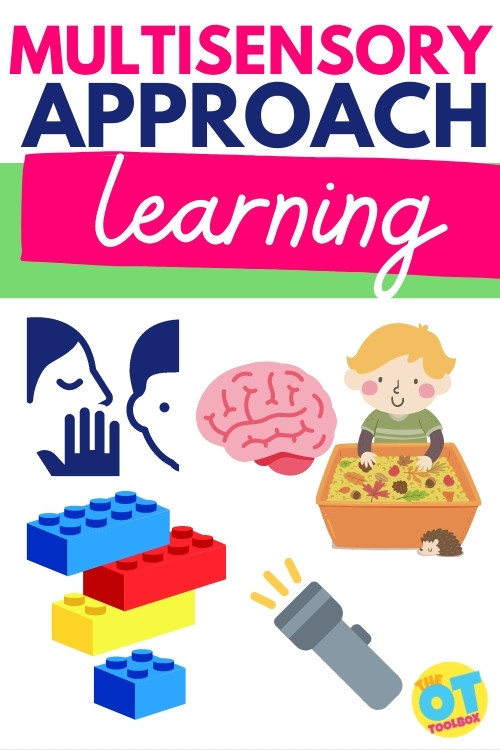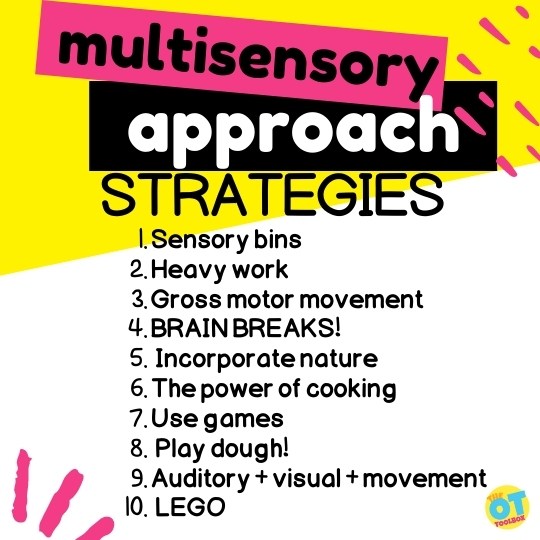Here we are covering easy ways to take a multisensory approach to academics. Occupational therapy and multisensory learning go hand in hand. And, when using the fundamental benefits of a several sensory areas in academics, the learner benefits. Let’s go a bit deeper, and then share 10 Fun Sensory Academic Activities.

A multisensory Approach to academics
Sensory rich activities can teach children academic skills, even if they don’t like to sit down and do worksheets. This blog includes 10 exciting ways to teach preschoolers new skills using sensory rich components such as tactile, visual, auditory and movement based components.
As a preschool teacher, I am always looking for new ways to teach academic skills to the children who aren’t interested in sitting and attending to small group activities. Tracing letters, taking turns with manipulatives and completing teacher directed tasks aren’t easy for some children. But I want to make sure they are learning the skills they need for Kindergarten readiness.
Read our resource on tracing sheets for a multisensory approach to learning letters.
When teachers use a multisensory teaching approach, there are many benefits that can be covered.
This blog explains the benefits of sensory play. “Sensory play offers many benefits. It expands children’s vocabulary as they learn about descriptors or attributes, like warm, rough, smooth, and slimy. It’s a great way to teach your children how to describe the world around them.
This type of exploration also supports development of fine and gross motor skills. When children are squeezing dough or holding a paint brush, they’re engaging the small muscles in their fingers and hands. During puddle jumping, they’re using their larger muscle groups.
Because sensory play is open-ended, it naturally fosters independence. They can explore the world and get creative with objects they are playing with. There’s no right or wrong way to play.”
As we work with these children becoming interested in group and social foundations (such as turn taking and participating in adult led activities) there are some other ways to teach foundational academic skills to these children using sensory rich components.
When children use multiple senses to learn new skills, they are not only able to remember the new skill more easily, they are able to attend to the activity longer. This article explains how sensory and attention are connected.

10 ways to take a multisensory approach to learning
Now that we’ve covered why a varied sensory offerings impact learning, let’s cover various ways to integrate the senses into a learning environment. Here are ten ways to impact learning through a multi-sensory approach.
1. Offer multisensory instruction with a sensory bin
Sensory bins are a novel environment for students to explore a new concepts. With a sneosy bin includes textures, movement, changes in body positioning, there are manu senses that are used at once while discovering a theme, concept, or idea. Learners can challenge the tactile sense, visual sense, proprioceptive sense, vestibular sense, and even olfactory sense in a sensory bin.
For preschoolers and older kids, try these ideas for multisensory learning using sensory bins:
Visual cues are such an important sensory component that we often forget about. When we see items, we learn how to differentiate them from others. A quick way to incorporate multisensory approach to learning colors, for example, can involve using colored sand or colored rice, to enhance the visual sense, tactile sense, and proprioceptive sense. Not only will children enjoy sorting the objects by color, they will be able to explore the items using their hands. They can scoop, stir, and pour the heavy medium while incorporating colored letters, different colored scoops, colored sensory bin cards, and other materials. Add some scoops to the bins to encourage fine motor development.
2. Add Nature for a multisensory approach to math
A favorite nature game, this activity uses the tactile sense to encourage movement, motor planning and number sense. Have the child use a bucket gather items they see while outside on a nature walk. They can gather rocks, pinecones, leaves, sticks, flower petals, etc. When you make it to the end of the walk, sort the items out into piles. Now, count how many of each item you have. Which one do they have the most of? The least of?
A nature-based sensory approach to adding, subtracting, sorting, patterning, shapes, etc. involves several sensory systems: auditory, tactile, visual, proprioceptive, vestibular, and olfactory.
A nature sensory walk can be applied to other learning concepts too, like in this nature rainbow hunt idea.
3. Use a movement-based approach in learning
One way to incorpoate the proprieoceptive and vestibular senses into learning (or kinesthetic learning, as some may consider this approach), is with a game-based learning experience. This can be accomplished with tossing bean bags, throwing a beach ball, balancing, or kicking a ball.
For example, Kick and Count is a game that teaches one to one correspondence to those kids that love to move! All you need are 5 balls and an outdoor area. Line of the 5 balls in a row and ask the child to count each ball before they kick it as hard as they can! You can even add in description words:
“Kick the ball hard, soft, slow, fast, up, straight, to the left, to the right, backwards… etc)
With any movement approach, add spelling words, facts, sight words, colors, names, etc. to the movement task.
4. Gross Motor Learning
Similar to the specific movement-based approaches listed above, a gross motor obstacle course type of learning activity can be used with learning concepts. The difference? This multisensory approach gets those heart rates up, integrating the interoceptive sense into learning.
For example, students can move around the room to find information cards, letters, spelling word cards, or other visual. More specifically, for kids that are learning to identify letters, match upper and lowercase letters, or write letters, you could use this alphabet bundle. In Alphabet Chase: Sammy Chases the Alphabet, kids can run, donkey kick, crab walk, or hop around the room to locate letter visuals.
After reading the story “Sammy Chases the Alphabet” place letter stickers onto ball pit balls and through them around the room. Have children find them, naming the letters that they find. This game is so much fun every child will enjoy learning their letters. Once children have identified the uppercase letters, switch out the alphabet on the ball pit balls to lowercase letters. Chasing after the alphabet is so much fun!
5. Take a multisensory approach to learning using games
There are so many great games that can be used in learning. Whether you are addressing math, phonetics, handwriting, reading fluency, science, or other area, games can be integrated into learning in some way. Take a look at these various ways to use games in learning. Coming from an OT’s perspective, we’ve been sure to include how these games complement functional skill areas and the senses.
Try to think of ways to use games like Simon Says, Head Bandz, Twister, Seven Up, Checkers, Connect 4 in learning. There are SO many ways to adapt a single game to meet the curriculum needs. Use these printable Simon Says commands.
6. Use cooking as a multisensory learning experience
Using cooking tasks for learning is a motivating and meaningful strategy for learning through the senses. Getting kids involved with cooking tasks is a must. Cooking offers not only a multisensory approach…there are SO many senses involved with cooking! But, cooking is a powerful learning tool, too.
When kids are active in the kitchen, they can look at math, reading, fractions, executive functioning skills, problem solving, eye-hand coordination, visual motor skills, fine motor skills and more. All of these cognitive skills and motor skills impact overall functioning.
7. Use Play Dough mats as a multisensory learning approach
For kids working on handwriting, fluency, comprehension, a quick way to add heavy work input is with a play dough warm-up. In therapy sessions, a handwriting play dough mat can be used for writing prompts. Work on letter formation, line use, spacing and other handwriting needs after heavy work input through the hands.
- This play dough mat deal is a steal with printable handouts for working out the hands and then working on handwriting.
- Address letter formation with these letter play dough mats that include a “sky line” and “dirt line” for line and size awareness in teaching letter formation.
8.Incorporate visual and auditory cues into learning
With the Soothing Sammy curriculum, you can address emotional regulation within learning experiences to help kids calm down using visual and auditory cues.
A learning experience that adds visual cues using a flashlight or pointer light plus auditory prompts adds to a typical classroom experience. Consider these tactics:
- Use a highlighter and black light for a fun visual twist
- Incorporate music
- Add low lights to learning for a change in the classroom environment
- Use the game “telephone” to pass on information
- Use whisper phones for reading
9. Utilize heavy work input using LEGO in multisensory learning strategies
Novel experiences like bringing in a bin of LEGO offers a fun and engaging learning experience. But when you stop to consider different ways to use one material, you get the wheels turning. Better yet, building with LEGO offers sensory input in many ways: proprioceptive input through the hands to click LEGO together and take them apart, visual processing, tactile input, and auditory processing as the bricks click together.
Use these learning with LEGO ideas for math, literacy, letter formation, pre-writing lines, and more.
How many ways can you think of to incorporate LEGO blocks into a multisensory approach to learning?
10. Use recycled containers in a multisensory approach to learning
One of the easiest ways to incorporate a variety of textures (tactile sense), weights (proprioceptive sense), colors (visual sense), and movement (vestibular sense) is by using a variety of materials. And, one trip to the recycle bin can fill your toolbox with the materials you need for learning at a no-brainer cost (FREE!).
These sensory-rich activities will engage any child and teach new skills through play. We all know how important it is for children to attend to tasks in circle time, group time and other important instances throughout the day.
- Use recycled containers in learning with these ideas.
- Use plastic lids in learning.
- Use a foam tray for multisensory learning.
- Use take-out lids for learning.
- Use bottle caps in learning.
- Use some of these toys and tools to help children attend in with these activities. (link: https://www.theottoolbox.com/toys-and-tools-to-help-with-attention/)
A final note on using a multisensory approach
As teachers, our goal is for all of our students to succeed. This list of 10 sensory rich academic activities can be used at home, at school or in therapy settings. With these ideas as a starting point, how can you adjust the multisensory themes to meet the needs of your classroom, educational curriculum, and students? Plus, don’t forget the power of brain breaks in learning. With many ideas out there, you can usually find a themed brain break that fits in with educational topics.
As children start to love learning, they will become more interested in participating in more adult directed tasks, preparing them for Kindergarten and Beyond. What is your favorite sensory-rich academic game?

Jeana Kinne is a veteran preschool teacher and director. She has over 20 years of experience in the Early Childhood Education field. Her Bachelors Degree is in Child Development and her Masters Degree is in Early Childhood Education. She has spent over 10 years as a coach, working with Parents and Preschool Teachers, and another 10 years working with infants and toddlers with special needs. She is also the author of the “Sammy the Golden Dog” series, teaching children important skills through play.






